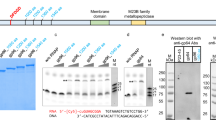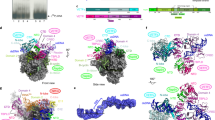Abstract
VACCINIA is a double-stranded DNA virus which replicates in the cytoplasm of animal cells. Soon after infection, the outer layers of the virion are removed to yield core particles1 which make mRNA that is transcribed, capped2 and polyadenylated3 by enzymes present in the cores. Later, the cores break down, DNA synthesis begins, and ‘late’ genes are expressed4. Cores can be made in vitro by treating virions with non-ionic detergent and mercapto-ethanol. When incubated with nucleoside triphosphates, these particles produce mRNA5 which can be translated in cell-free systems to yield authentic vaccinia early proteins3,6,7. It has recently been suggested that this mRNA may be derived from large primary transcripts8 which are processed in a manner similar to that proposed for cellular mRNA9,10. I have obtained evidence that early vaccinia mRNA is made by monocistronic transcription in vitro, by comparing the relative sensitivity of the synthesis of individual messages to ultraviolet irradiation. Production of mRNA was assayed indirectly using a coupled cell-free transcription–translation system in which protein synthesis is dependent on added vaccinia cores.
This is a preview of subscription content, access via your institution
Access options
Subscribe to this journal
Receive 51 print issues and online access
$199.00 per year
only $3.90 per issue
Buy this article
- Purchase on Springer Link
- Instant access to full article PDF
Prices may be subject to local taxes which are calculated during checkout
Similar content being viewed by others
References
Dales, S. J. Cell Biol. 18, 51–72 (1963).
Moss, B., Gershowitz, A., Wei, C.-M. & Boone, R. Virology 72, 341–351 (1976).
Nevins, J. R. & Joklik, W. K. Virology 63, 1–14 (1975).
Joklik, W. K. A. Rev. Microbiol 22, 359–390 (1968).
Kates, J. & Beeson, J. J. molec. Biol. 50, 1–18 (1970).
Fournier, F. et al. FEBS Lett. 30, 268–272 (1973).
Jaureguiberry, G., Ben-Hamida, F., Chapeville, F. & Beaud, G. J. Virol. 15, 1467–1474 (1975).
Paoletti, E. J. biol. Chim. 252, 866–871 & 872–877 (1977).
Lewin, B. Cell 4, 11–20 & 77–93 (1975).
Molloy, G. R., Jelinek, W., Salditt, M. & Darnell, J. E. Cell 1, 43–53 (1974).
Michalke, H. & Bremer, H. J. molec. Biol. 41, 1–23 (1969).
Hercules, K. & Sauerbier, W. J. Virol 12, 872–881 (1973).
Bräutigam, A. R. & Sauerbier, W. J. Virol. 13, 1110–1117(1974).
Goldberg, S., Weber, J. & Darnell, J. E. Cell 10, 617–621 (1977).
Ball, L. A. & White, C. N. Proc. natn. Acat. Sci. U.S.A. 73, 442–446 (1976).
Abraham, G. & Banerjee, A. K. Proc. natn. Acad. Sci. U.S.A. 73, 1504–1508 (1976).
Glazier, K., Raghow, R. & Kingsbury, D. W. J. Virol. 21, 863–871 (1977).
Pelham, H. R. B. & Jackson, R. J. Eur. J. Biochem. 67, 247–256 (1976).
O'Farrell, P. H. J. biol. Chem. 250, 4007–4021 (1975).
Laskey, R. A. & Mills, A. D. Eur. J. Biochem. 56, 335–341 (1975).
Darnbrough, C. H., Legon, S., Hunt, T. & Jackson, R. J. J. molec. Biol. 76, 379–403 (1973).
Hunter, A. R., Hunt, T., Jackson, R. J. & Robertson, H. D. J. biol. Chem. 250, 409–417 (1975).
Author information
Authors and Affiliations
Rights and permissions
About this article
Cite this article
PELHAM, H. Use of coupled transcription and translation to study mRNA production by vaccinia cores. Nature 269, 532–534 (1977). https://doi.org/10.1038/269532a0
Received:
Accepted:
Published:
Issue Date:
DOI: https://doi.org/10.1038/269532a0
This article is cited by
-
Cell-free systems in the new age of synthetic biology
Frontiers of Chemical Science and Engineering (2017)
-
Organization and expression of the poxvirus genome
Experientia (1982)
Comments
By submitting a comment you agree to abide by our Terms and Community Guidelines. If you find something abusive or that does not comply with our terms or guidelines please flag it as inappropriate.



